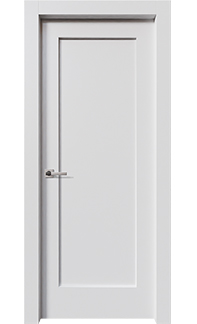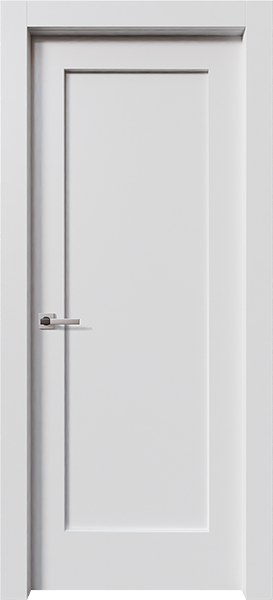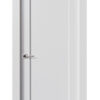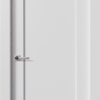Description
THE DOOR NAME ORIGIN – “SHAKER STYLE 1 PANEL”
How many panels should your interior door have? Well! If you’re looking for a truly no-frills product that is nonetheless elegant, this is an interior door you should consider first. This one-panel model is a truly minimal shaker-style design.
While just as reliable as the interior doors in our other collections, these interior doors cost less. A lot less, in fact. Again, if simplicity is your thing, do consider this model.
The original Shakers (or Shaking Quackers, as they were styled back in the Nineteenth Century) would be immensely pleased to have this product, as it most certainly adheres to their principle of utter simplicity combined with reliability. In its heyday, the community was highly influential when it came to matters of taste, not just in the United States, but in many other countries. The Baroque period that emphasized and worshipped unapologetic, insolent luxury had come to an end. Austere classicism was the hottest new trend in architecture. Furniture, cabinets, interior doors, and other parts of decor were undergoing similar changes, with the shaker style showing the way and shaming those still trying, however subtly, to preserve some of the erstwhile ideas of sumptuousness in their construction projects.
From New England and New York the community continued steadily to spread westward, bringing with it its principles.
One of which was this: never waste material. They were firmly opposed to excessive ornamentation, layered moldings, picturesque architraves, fancy floor boards – their ideas were the exact opposite of those that had dominated the preceding era (which, need I remind you, peaked when Baroque designers introduced the new movement known today as Rococo, a style so sumptuous it would have made even Louis XIV, the celebrated Sun-King, cover his face in shame.
Simplicity, however, does not mean that dependability – and even elegance, for that matter – suddenly went out the window. On the contrary, each furniture item was highly functional and enduring – as all interior doors produced by the Almes team are.
That’s right. For instance:
As members of the Hi-Dur collection, each Shaker Style interior door is “wrapped” rather than finished: a highly technological process that, through heat and pressure, effectively fuses the materials, making the resulting product scratch-resistant, water-proof, warp-proof and fade-proof.
As all Almes doors, this one-panel job comes with our usual great features, such as the state-of-the-art hardware. The Italian-made 3D-adjustable self-lubricating concealed hinges? Absolutely. (They make the interior door a great deal easier to install than any other kind; they will never creak; and you won’t see the pin from either side of the door because, well, there is no pin).
The magnetic lock is, of course, soundless and utterly dependable. The automatic sweep, should you choose the option, will raise your interior door’s sound proofing and thermal insulation qualities well above the industry standard.
All the usual configurations are available, of course, including swing, pocket, barn, bi-fold and bypass, as well as all the standard sizes, and custom orders are most certainly welcome. Picking the right color for your interior door should be fun, too!
FINISH: PRIMED
The advantages of this approach – of this type of interior door finish – are fairly obvious. Pick a color, any color that suits your projects best. Mix and apply. Re- coat whenever you feel it is necessary to do so. Touch it up. It gives you, the proud owner of these interior doors, complete freedom of choice, and the significant savings, especially where it comes to bulk orders, can be a true source of joy.
As Kurt Vonnegut mentions in one of his novels (Bluebeard, unless I’m mistaken … check it out when you get a chance), the thrill of laying on colors is a large part of the artist’s professional satisfaction. In other words, a keen pleasure.
When back in the remote past visual arts became a field dominated by professionals rather than hobbyists, the main problem of “just laying on paint” became obvious: you can’t.
The medium of choice back then was egg tempera, a permanent, fast-drying substance consisting of colored pigments mixed with a water-soluble binder medium, usually glutinous material such as egg yolk. Portraits and ornaments were executed in this medium, and the wood panel was the surface of choice. One of tempera’s interesting features is that it is not as easily absorbed by wood as other mediums. Some sort of primer was necessary, of course, but pretty much any substance that dried evenly could be used.
The drawbacks of tempera, or pintura al temple, as the Spanish call it, only became obvious with the advent of the Renaissance, when the leading representatives of the trade turned to oil (and interior doors suddenly became a great deal less crude, but that’s a story for another day).
Oil painting is the process of “painting with pigments with a medium of drying oil as the binder.” Commonly used types include linseed (highly preferable in art, though not necessarily in interior doors, mind you), poppy seed, walnut, and safflower.
Today, five hundred years later, it is safe to say that oil is more versatile than pintura al temple – by orders of magnitude. Specifically, the contrasts achieved through the former are much greater, the darks are far deeper, and three- dimensional, highly realistic images are much easier to achieve. Next time you visit a museum, take a closer look at pintura al temple portraits. All of them, without exception, come off as a bit “flat” as opposed to their latter-day counterparts.
Also, where glazing is concerned …
Glazing: a painting technique in which a transparent layer, with just a touch of pigment, is laid over a previously painted surface, allowing light to travel through the glaze and be reflected back off of the opaque layer below. Gentle shadows, subtle changes of color, smooth transitions – all these can be achieved through glazing, which was used by all artists up until the middle of the Nineteenth Century, when artist tubes were invented, revolutionizing the field, and other techniques began to be explored.
Tempera enthusiasts (it takes all kinds to make a world) will assure you that glazing is not just possible in pintura al temple but is actually the basis of the whole enterprise. Well, what are you going to do? They’re enthusiasts.
Anyway, la peinture à l’huile, as the French call it, re-introduced the ancient problem of most surface’s propensity to absorb dipingere, as the Italians call the stuff. Wood or canvas, it is all the same: you’re not going to get very far without a good primer.
Experiments were conducted, and soon rabbit skin glue emerged as the least expensive and most effective solution. It was easy to apply. It dried evenly. It made the application of the l’huile stuff on top of it a walk in the park.
There were drawbacks. Today, rabbit skin glue is considered to be a major cause of cracking by most modern conservators. (Remember, when you visited the Metropolitan Museum of Art – and did you see those interior doors? … some of them are quite something … – most “old masters” pictures are completely covered with a cobweb of cracks? There you go). Because the glue is hygroscopic, it continually absorbs moisture from the atmosphere, causing the glue to swell and shrink as ambient humidity levels change. Over many humidity cycles, this repeated flexing causes the brittle oily layers to crack.
To combat this problem, modern primers are made of acrylic materials which are guaranteed not to cause any damage to the dipingere. No bubbling, no cracks. Your interior doors are safe.










